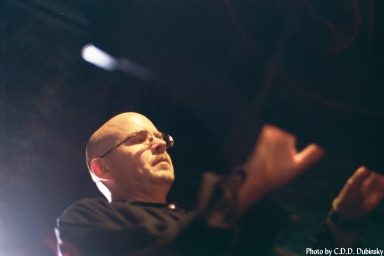Song Improvisation 
© 2001 David SchmollLet me begin by stating that singing ability is not a prerequisite to successful song improvisation. It helps, but itís not absolutely necessary. If youíre not such a great singer, the bad news is that the mechanics of singing may be a bit more difficult for you to grasp at first. However, the good news is that this difficulty is really a blessing in disguise. If youíre the type who canít carry a tune in a bucket, song improvisation stretches you as an actor. It forces you to make a strong, charismatic character choice and then sell the living you-know-what out of it (if you believe it, the audience will believe it ñ often, without realizing that all youíre really doing is talking your way through it).
For the non-musician, working with music can be intimidating because it seems so complicated. There are many new techniques to learn, and they are all used simultaneously ñ you have to keep track of your rhymes, while counting your lines, and making smooth transitions from one section to the next ñ and you must do all this (and more) while always serving the goal of organically moving forward toward your songís natural, logical conclusion.
No wonder this seems so convoluted! But if you break these seemingly difficult tasks down to smaller pieces, you realize itís not really that hard. It gets a lot easier, and a lot more fun, once you know what theses pieces are and how they fit together.
The Musical Clock
(or, How to Write a Paper About Song Improvisation)Musically, a song is really nothing more than a clock ñ itís a way of marking the amount of time that passes between the beginning and the ending of a complete musical idea. Just like we have days that are split up into hours, minutes and seconds, we also have songs containing verses and choruses that are split up into phrases, measures, and beats. These components function as a means of knowing when itís time to move from point A to point B. They are arranged in a hierarchy from largest to smallest, as demonstrated in this diagram.
Lyrically, a song is a story. It can first be split up into exposition, thesis, and twist, then into paragraphs, and then into lines, words, and even letters.
The Paragraphs: The Verse, Chorus, and Bridge
Not all songs contain all three of these elements, but you should know what each of them does so you have the widest possible range of choices.
The verse is your exposition; it provides your listener with the necessary information needed to get to the point of the song. This information usually takes the form of who-what-when-where-why-how. As we will see when we start looking at song structures, the verse is universal to every song, and sometimes it is the only element of a song. When this is the case, the verse does double duty by giving information and then summarizing it, usually with a line that is repeated at the beginning or (more typically) at the end of every verse.
Although the chorus is not used universally, it appears in most popular songs. When using a chorus, bear in mind that itís the most crucial part of the song. This is your thesis ñ the summary, or the central idea you are putting across to the listener. When improvising a song, itís best to keep the chorus simple and memorable. There are two reasons for this: a) you want to give the audience a catchy hook that will stay with them after the song ends, and b) you have to remember what you did with the first chorus when it comes time to repeat it later in the song.
Unlike the verse and chorus, which usually appear twice or more in a pop song, the bridge is unique and is only offered once. Musically and lyrically, the bridge is different from the verse and chorus, and it provides a twist ñ a last bit of crucial information that will take the listener into the final chorus. Use the bridge to generate some sort of tension, which will be released when you move into the final chorus.
The Sentences, Words and Letters:
Phrases (lines) Measures (bars) and BeatsFor our purposes here, we will assume interchangeability between the terms ìphraseî and ìline.î Continuing our analogy of writing a story, if the verse, chorus and bridge are paragraphs, lines or phrases are the equivalent of one sentence within the paragraph. Often, a verse, chorus, or bridge will be laid out in four lines with a rhyme scheme of A-A, B-B (say-may, night-flight) or A-B, A-B (say-night, may-flight). Assuming four lines per verse, each phrase would be ¼ the length of the total verse.
Each line or phrase can be divided into measures, also called bars ñ the words of the sentence. Typically, there will be two or four measures per line, depending on the tempo of the song (slower tempos gravitate towards two bars per line, faster tempos often include four bars per line). So, we see that a measure is either ½ or ¼ the length of the total line.
Finally, the smallest unit of measure in our musical clock is the beat ñ the letters that make up the words. In most popular music, there are four beats per measure, and these four beats can each be divided into two smaller beats (giving eight beats that are ½ the duration of a whole beat) or into four smaller beats (giving 16 beats that are ¼ the duration of a whole beat). Whenever you hear funky, syncopated rhythms in a song, what you are really hearing are these smaller ìsub-beatsî being accented within the measure.